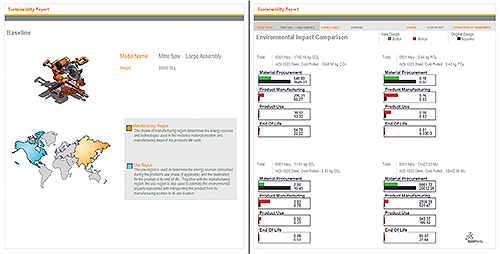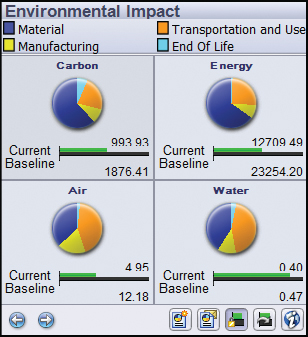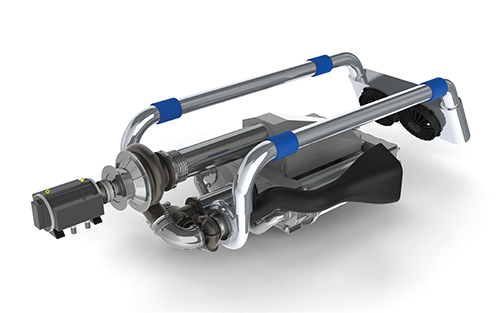May 28, 2011
Manufacturers that effectively adopt sustainable design practices will position themselves to successfully respond to increasing consumer demand for “greener” products.
Sustainability is one of the latest buzz words among manufacturers and their customers. However, implementing a sustainable design strategy can be challenging because of misconceptions about costs versus benefits, as well as questions about how to effectively implement sustainable design.
SolidWorks Sustainability enables you to automatically produce environmental impact reports that are easy to follow and understand.
For a technology-based solution to be effective in facilitating a game change as significant as sustainable design, it must take into account the strategies required to effect the transition. SolidWorks Sustainability software provides manufacturers with the product life cycle information they need to make good product development decisions regarding sustainability. The information generated as a result of life cycle assessment (LCA)-based sustainable design establishes the foundation for successfully executing the planning, development, manufacturing, communication, and marketing strategies that will drive your company’s sustainability efforts forward.
The software allows you to assess and evaluate environmental impacts before making any hard investments in materials or machinery. You can use this information to create breakthrough innovations, introduce new processes, communicate sustainable initiatives, and market greener products.
In addition, the software allows you to measure the environmental impact of the products you design in SolidWorks CAD software. Because SolidWorks Sustainability is integrated inside SolidWorks, it provides real-time feedback on environmental impact in four key areas:
• Carbon footprint
• Total energy consumed
• Effect on water
• Effect on air
This LCA information is generated through the GaBi database and material/process model created by PE International, a provider of sustainable design and software services. SolidWorks Sustainability results provide valuable estimates that can help guide your sustainability efforts. The accuracy of the results improves when you use the software to track the relative changes from one version of a design to the next.
The ability to estimate environmental impacts during product design – at the single component, individual assembly, and complete product level – adds a new dimension to your product development process. Heretofore, product design primarily focused on performance and manufacturing issues, including fit and function, safety and failure concerns, and design manufacturability and production costs.
With SolidWorks Sustainability software, you will have an Environmental Impact Dashboard as part of your design system so you can estimate environmental impacts for each stage of a product’s life cycle including:
• Raw materials extraction
• Material processing
• Part manufacturing
• Assembly
• Product use
• End of life
The software can generate the following estimates:
• Carbon footprint: It measures the units of carbon dioxide equivalent (CO2e) emitted.
• Total energy consumed: It measures the consumption of non-renewable energy associated with the design’s lifecycle in units of mega joules (MJs).
• Air acidification: It measures the units of kilogram sulfur dioxide equivalent (SO2) emitted into the atmosphere used as a measure of overall environmental impact to the air.
• Water eutrophication: It measures the units of kilogram phosphate equivalent (PO4) released, used as a measure of overall environmental impact to the water.
The quest for more sustainable products can stimulate innovation, such as this gas turbine for hybrid buses and trucks.
Engineers previously have not had this type of information readily available. The software provides new insights and guidance on environmental impact. This approach gives your organization the sustainability data that you need to make informed choices. Adding an environmental impact assessment tool to your product design system gives you access to information that can spark creativity and innovation, helping you to design greener products.
Sustainable design is not always an all-or-nothing proposition. Many manufacturers will undertake a phased, gradual approach. By providing guidance on how to rethink existing products to make them more eco-friendly and how to develop next-generation, green products, SolidWorks Sustainability helps you implement sustainable design in a way that fits your business.
Increasingly, consumers consider the environmental impact of the products that they buy. They want to know about how and from what a product is made. SolidWorks Sustainability offers the tools that product developers need to create products that can influence these purchasing decisions, so your company can capitalize on the growing demand for sustainable products.
For example, by using tools such as Find Similar Materials, you can explore a variety of alternative materials that not only are more eco-friendly, but also are potentially cheaper, less costly to manufacture, and more desirable in the marketplace. In a similar fashion, SolidWorks Sustainability can help you investigate energy efficiency strategies to make your green products even greener.
The ability to estimate environmental impacts during product design – at the single component, individual assembly, and complete product level – adds a new dimension to your product development process. Heretofore, product design primarily focused on performance and manufacturing issues, including fit and function, safety and failure concerns, and design manufacturability and production costs.
With SolidWorks Sustainability software, you will have an Environmental Impact Dashboard as part of your design system so you can estimate environmental impacts for each stage of a product’s life cycle including:
• Raw materials extraction
• Material processing
• Part manufacturing
• Assembly
• Product use
• End of life
The software can generate the following estimates:
• Carbon footprint: It measures the units of carbon dioxide equivalent (CO2e) emitted.
• Total energy consumed: It measures the consumption of non-renewable energy associated with the design’s lifecycle in units of mega joules (MJs).
• Air acidification: It measures the units of kilogram sulfur dioxide equivalent (SO2) emitted into the atmosphere used as a measure of overall environmental impact to the air.
• Water eutrophication: It measures the units of kilogram phosphate equivalent (PO4) released, used as a measure of overall environmental impact to the water.
The quest for more sustainable products can stimulate innovation, such as this gas turbine for hybrid buses and trucks.
Engineers previously have not had this type of information readily available. The software provides new insights and guidance on environmental impact. This approach gives your organization the sustainability data that you need to make informed choices. Adding an environmental impact assessment tool to your product design system gives you access to information that can spark creativity and innovation, helping you to design greener products.
Sustainable design is not always an all-or-nothing proposition. Many manufacturers will undertake a phased, gradual approach. By providing guidance on how to rethink existing products to make them more eco-friendly and how to develop next-generation, green products, SolidWorks Sustainability helps you implement sustainable design in a way that fits your business.
Increasingly, consumers consider the environmental impact of the products that they buy. They want to know about how and from what a product is made. SolidWorks Sustainability offers the tools that product developers need to create products that can influence these purchasing decisions, so your company can capitalize on the growing demand for sustainable products.
For example, by using tools such as Find Similar Materials, you can explore a variety of alternative materials that not only are more eco-friendly, but also are potentially cheaper, less costly to manufacture, and more desirable in the marketplace. In a similar fashion, SolidWorks Sustainability can help you investigate energy efficiency strategies to make your green products even greener.
Consumer demand for eco-friendly products can lead to innovative new designs, such as the Tango electric car from Commuter Cars Corporation. SolidWorks Sustainability can help you make green products like this one even greener.
You can encourage your suppliers to use SolidWorks Sustainability Xpress, the free, limited version of the software to save their specific sustainability information within their SolidWorks part files, which improves the transparency of the environmental impact information for purchased parts. You can use this feature to embed sustainability information in subsequent products that you deliver to your customers.









No comments:
Post a Comment